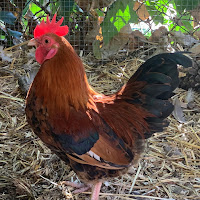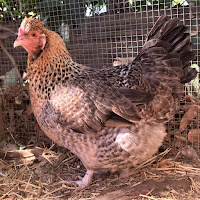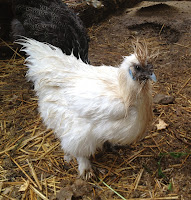When people talk about chickens - especially backyard chickens - the subject of eggs always comes up.
 |
| Eggs |
Inevitably certain questions about eggs come up as well. Questions like...
Do fresh eggs really taste better than the ones you can buy in the store?
Don’t you need a rooster in order for your hens to lay eggs?
If you have a rooster, aren’t all of your eggs going to be fertilized?
Can you eat fertile eggs?
Well, the first question is easy to answer. The eggs my hens lay absolutely taste better than those bought from a store. You can even see how much better they taste because the yolks are a deep orange instead of a pale yellow. But this is a subject for a different blog post.
As for the second question, as any chicken owner can tell you, hens do not need a rooster to lay eggs. The egg laying process happens with or without a rooster being present. But if a rooster is present... well this brings us to not only the third question, but the subject of this blog post.
Fertilized Eggs
And now that we ourselves have a rooster in our Flock - and what a rooster Rudy is! - the idea and question of fertilized eggs has come up a lot. (Check out my previous post HERE to learn more about Rudy.)
So let’s answer those remaining two questions: Will all of the eggs our Girls lay be fertilized? And also: Can we eat those fertilized eggs?
To dive into these questions, I think we first must understand how the fertilization process in animals like birds and other egg-laying animals works. This brings us to two different types of fertilization.
Internal Fertilization and External Fertilization.
External Fertilization is used by a whole slew of animals. Animals such as most fish - Salmon and Cod and Trout are just a few to mention. It’s also used by amphibians - Frogs and Toads and Salamanders and such. And it’s even used by animals such as Clams and Coral and Sea Anemones.
The basic way external fertilization works is this: |
| External Fertilization is my business. Business is good. |
The female of the species releases a large amount of eggs from her body. These eggs are immediately fertilized with sperm from a male. Some fish and amphibians will do this in safer places where the eggs won’t just be swept away by tide or current. Others, like Coral and Sea Anemones will just let their eggs fly and hope they join with the sperm the males of their species let loose into the water. One of the reasons this works is that the amount of eggs and sperm released by these animals is absolutely immense. Millions upon millions of each. And chances are, because of this, a good amount of eggs will be fertilized.
This brings us to Internal Fertilization, which is exactly what it sounds like. The eggs that the female will lay (but hasn't yet) are fertilized while still inside of her body. These eggs will then be “Fertile” when they are indeed laid. As a quick note, believe it or not there are some fish that use internal fertilization. Fish like Guppies and Mollies and Mosquitofish among others. Their eggs will be fertilized by the male of the species using a special fin called a gonopodium fin to deposit sperm onto the eggs inside of the female. And the female’s fry will be “born” live in the water once the eggs inside of her hatch.
To belabor the point - see what I did there? - here’s a video I found on YouTube of a mama guppy giving birth to her fry.
This brings us to Chickens. It always comes back to Chickens, doesn't it?
Chickens
- and all birds, actually - reproduce using Internal Fertilization. Which means that sperm from the male was placed into the female and her eggs are fertilized
before they are ever laid. So, to clarify...
An egg can only be fertilized by a rooster before it is laid. That means that once an egg flies out of a chicken and hits the nest, if it’s not fertilized at that point it cannot be fertilized.
Okay. So now with all of that information out of the way, let’s answer - or try to answer - the questions from earlier.
Will all of the eggs our Girls lay be fertile?
Chances are, yes. If a rooster is doing his job then the eggs that are laid by the hens will be fertile. And this can start in as little as a day or two after putting a rooster and your hens together. In fact, after a rooster and hen mate, even if you separate them, the hen can still lay fertile eggs for about two weeks. Why? Because the rooster’s sperm is stored in the hen’s oviduct - the tube that the newly-forming egg travels through from the hen’s ovary in order to be laid. It would be during this “traveling” that the forming egg would be fertilized by the sperm that’s just waiting around to do its job.
That pretty much answers that question. Yes. The eggs will be fertile.
Which brings us to: Can we eat those fertile eggs?
And the simple answer to this question is: Absolutely!
In fact there are several grocery stores that sell fertile eggs, Whole Foods Market and Trader Joe’s being just two of them.
And while fertilization means that ultimately, if given enough time and the right atmosphere, and temperature, and humidity, there will be a baby chicken inside of the egg, if the egg is removed from the nest and refrigerated in a timely manner any and all development inside of that egg stops. Now. If you leave a clutch of eggs under a chicken for more than a couple days, then development will have not only started, but progressed. So. Yeah. No.
Is there a way to tell a fertile egg from a non-fertile egg before cracking it open? Yes. And the method is called “Candling”. Basically, after about a week (although I’ve read it could be in as little as three days) the egg is held up to a bright light so its interior can be observed through its exterior. From this there will be specific signs of fertilization or not. And it’s called Candling because back in the day eggs would be held before a candle flame to see what was going on inside. I won’t get into the what of it all, but click HERE for information on candling. In short, though, Candling is used to see which eggs are developing enough to try and hatch. So, in my opinion, considering you’re waiting more than a few days in order to find all of this out, it’s not the best option if you’re looking to eat the egg. Again. My opinion.
Other than that, the only other way to tell if an egg is fertile is to crack it open and see if there is the tell-tale sign of fertilization. Let's get into that!
In an unfertilized egg there will be a small, faint whitish spot inside of the yolk. This is called the Blastodisc. And it’s perfectly normal. If you see this single little spot in the yolk - and it can be extremely hard to see sometimes - the egg is not fertile.
 |
| From Alabama Cooperative Extension System (aces.edu) |
However, if that little faint whitish spot in the yolk looks more like a little faint whitish bullseye - a small dot with a small ring around it - you’ve just found the Blastoderm. If you see it - and if you’re not looking for it you might not even notice it - then you’re dealing with a fertile egg.
 |
| From Alabama Cooperative Extension System (aces.edu) |
I guess there is a third way to tell if the egg is fertile. And that’s to let it sit under a hen for three weeks. If it hatches, it was fertile. If it doesn't, it wasn't.
So there you go. Our questions have been pretty much answered.
Yes, our eggs - considering we have a rooster who knows his job only all too well - will most likely be fertile. And Yes, considering we pull our eggs out of our hens' laying boxes almost immediately after they are laid, we can and definitely are eating them.
And they are eggs-cellent!




















